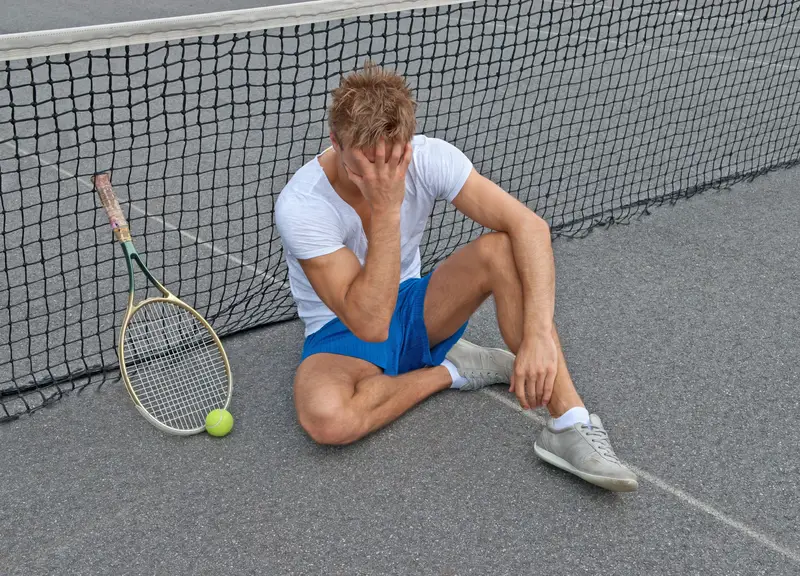- An error that is hit without being under any perceived pressure
- Reasons – poor form, pressure, bad footwork, threat of opponents next shot
- Examples – double fault, missed rally ball, missed mid-court ball
Your Guide
 Gavin Davison
Gavin Davison
There are few things MORE FRUSTRATING in tennis than unforced errors. Hit too many and your opponent could win the match without needing to do too much.
As detailed above, an unforced error describes any error that has been hit without being under any pressure.

Everyone from amateurs to PROS HIT unforced errors.
But of course, professionals will hit fewer unforced errors than your average club player, IN THEORY.
In short, your goal should be to hit as few unforced errors in tennis as possible.
This means you won’t be giving your opponent too many ‘cheap points’.
Take Rafael Nadal as an example, ESPECIALLY ON CLAY. The guy barely gives you a free point, meaning that his unforced error count is typically VERY LOW.
The fact that he can get many balls back in play is also a nightmare for opponents, hence his success.
Which other player gives opponents makes fewer points from unforced errors?
Another guy who is amazing at reducing the unforced error count is Novak Djokovic.
In fact, that’s partly why he was able to beat Nadal at the 2021 French Open!
Therefore, it’s NO SUPRISE that these two are some of the best players on tour.
But are unforced errors really that easy to avoid, and what contributes to them?
Ways of hitting an unforced error
Unforced errors can be hit in ALL KINDS OF WAYS.
But regardless of how they are hit, they are always documented as AN ERROR that was hit without being under pressure.
Here are the different ways of hitting an unforced error:
Double fault
Of course, with the server starting the point in tennis, they are under NO PRESSURE at all.
The server simply tosses up the ball and hits it to kick things off.
In tennis, you get a first and a second serve. If you miss both, not only is this classed as a double fault, but it’s also classed as an unforced error.
These tend to be higher for guys who try to GO BIG on first and second serves.
However, the double fault count can always be higher for guys when facing a great returner, as this actually CREATES PRESSURE on the quality of the serve.
Hitting the Ball Long
Keeping a good length on YOUR GROUNDSTROKES is the best way to prevent the opponent from attacking the ball.
But hitting the ball within a few inches of the baseline is difficult, EVEN FOR GREAT PLAYERS.
That’s where unforced errors can arise from hitting the ball long, as a player can simply be trying to keep a great length time and time again.
Naturally, the margin for error is VERY SMALL at the top of the game!
Hitting the Ball Wide
One of the best ways to maneuver your opponent around the court is to hit angles.
But sometimes, you might like to try and CLEAN THE LINE on a groundstroke to hit an immediate winner.
Either way, YOU’LL BE TRYING to place the ball close to the lines, which can and does result in unforced errors.
Hitting the Ball in the Net
That pesky net has a habit of getting in the way at times, right?
Then again, tennis wouldn’t be the same WITHOUT THE NET standing in the way.
Of course, hitting the ball in the net without being under any pressure goes down as an unforced error.
Guys that hit the ball very flat tend to hit unforced errors in this way, as they have very little net clearance on their groundstrokes.
What contributes towards a higher unforced error count?
If you hit a high number of unforced errors in a game, you’re always going to be up against it.
This means you are giving your opponent MANY CHEAP POINTS.
In my experience, and from players I’ve coached over the years, there are four reasons for unforced errors:
1) Poor Footwork
Sloppy footwork results in you being in the WRONG POSITION for the shot.
If you get too close, the ball gets TOO FAR, or your contact point is off, there’s a higher chance you’ll miss the ball.
That’s why footwork is so amazingly important in tennis.
So if you’re hitting quite a few unforced errors, you’ll want to CHECK YOUR FOOTWORK!
2) Opposition Pressure
Trying to hit the ball close to the line is often a response to your opponent playing good tennis.
Especially if they are big hitters, you’ll feel MORE PRESSURE to keep them pinned back and stop them from controlling the point.
This creates a subconscious need to try and play things a LITTLE RISKIER, resulting in unforced errors.
3) Scoreboard Pressure
Nobody is immune from pressure.
Even the greats like Djokovic and Federer start to miss a few balls when they are up against it.
At big moments, you may be MORE LIKELY to hit an unforced error because you’ll get nervous, or ‘tight’ as we like to call it in tennis.
This often throws your footwork off, YOUR ARMS GETS HEAVY, and your strokes won’t be as precise or smooth.
4) Going for Too Much
If you like to ATTACK THE BALL, this one’s for you.
When you are trying to push the opponent, hit clean winners, or just dominate the point – there is a higher chance that YOU’LL MISS.
That’s just part of the game, although if you are trying to play too risky for whatever reason, your unforced error count will certainly rise.
If this happens, you may want to rein things in a bit.
The impact that unforced errors have on a match
You’ve probably guessed that a high unforced error count is bad for your game.
More to the point, it can be CATASTROPHIC when trying to win matches.
Hit too many and your confidence will fade, your opponent will be OVERJOYED, and you’ll get incredibly frustrated.
Consistent unforced errors also means that the scoreboard will KEEP TICKING OVER in the wrong direction from your perspective too.
If you’ve been there before, I highly recommend tightening your game up a bit.
These are the things you ought to start doing:
- Play further from the lines
- Hit with less pace
- Keep your footwork intense, and
- Give the net more clearance
Incorporate these and I am pretty confident that your error count will decrease.
Have anything to add? Jump into the comments and let us know!


